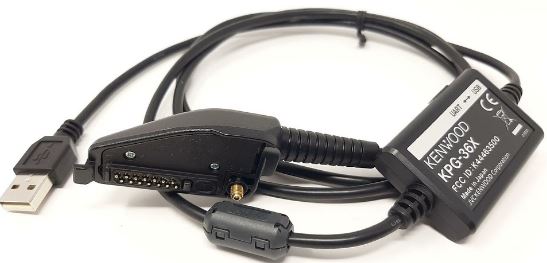KENWOOD KPG-36X USB Programming Interface Cable Instruction Manual

KENWOOD KPG-36X USB Programming Interface Cable 

SUPPLIED ITEMS
- USB programming interface cable (USB 2.0 Full speed (12 Mb/s) compliant) <cable length: 4.92 ft/ 1.5 m>
- CD (with driver software)
- Instruction manual (B5A-0568-XX)
OPERATING SYSTEM
Windows Vista (32/ 64-bit)/ Windows 7 (32/ 64-bit)/ Windows 8 (32/ 64-bit)/ Windows 8.1 (32/ 64-bit)
INSTALLING THE DRIVER
When using the KPG-36X/ 46X for the first time, install the supplied KPG-36X/ 46X driver.
ATTENTION
- For software, use version 6.00 or later.
- For KFL software, use version 1.10 or later.
- Depending on the usage condition of the USB apparatus, saved content may be lost. KENWOOD does not take responsibility for damages or lost content.
- Turn on the computer, then insert the supplied CD into the CD-ROM drive of the computer.
- When using KPG-36X/ 46X for NX-5200/ NX-5300/ NX-5400/ NX-5700/ NX-5800, the USB driver whose transfer rate is faster than the UART driver or the current UART driver can be selected. Refer to the service manual for other models, and if there are not any specifi c descriptions, select UART driver.
If installing the UART driver:
Double-click the CP210xVCP folder . Double-click the [CP210xVCPInstaller_x64.exe] or [CP210xVCPInstaller_x86.exe]fi le. When installation Wizard starts, click [Next>].
If installing the USB driver:
Double click [Kenwood_Communications_Product_ USB_Port_Type1] folder. Double click the [Kenwood_ Type_1_USB_Driver_32bit.exe] or [Kenwood_Type_1_ USB_Driver_64bit.exe] fi le. When the Installation Wizard starts, click [Next>] .- Concerning the 64-bit version or 32-bit version, you should check the PC in advance.
- Read through the licensing agreement. If you consent to the terms of the agreement, check the “I accept this agreement” box, then click [Next>].
- Start the installation.
- When the driver finishes copying to the computer, click the [Finish].
Note:
- The KPG-36X/ 46X is installed as a virtual port driver.
- The KPG-36X/ 46X does not support programs other than those used for KENWOOD transceivers.
- If the driver cannot be installed or if, having installed the driver and restarted your computer, the driver cannot be found or the operation does not stabilize, try changing the USB port to that which you have connected the KPG-36X/ 46X. Additionally, try removing other equipment attached to the computer USB ports.
- Access the following URL for the driver download information: http://www.kenwood.com/usb-com/
CONNECTING TO A COMPUTER AND TRANSCEIVER
Connect one of the KPG-36X/ 46X USB connectors to the USB port of the PC, and the other connector to the transceiver.
Note:
- Connect the KPG-36X/ 46X directly to the transceiver and the PC (or USB HUB).
- Do not connect the KPG-36X/ 46X other than PC (or USB HUB). It causes malfunction of the KPG-36X/ 46X and the transceiver.
ABOUT SELECTING USB/ UART
For using USB (Up to 12 Mb/s USB Speed), Slide the SW of KPG-36X/ 46X to USB. For using UART (RS-232C), Slide the SW of KPG-36X/ 46X to UART.
CONFIRMING THE INSTALLATION
Connect the KPG-36X/ 46X to a USB port, In the “Device Manager”, open the “Port(COM and LPT)”. In case of the SW position of UART, If “Silicon Labs CP210x USB to UART Bridge(COMx)” appears, installation is complete. In case of the SW position of USB, “KENWOOD Type1(COMx)” appears, installation is complete.
UNINSTALLING THE DRIVER
In the “Program Installation and Deletion” screen, uninstall the following item: “Windows Driver Package – Silicon Laboratories (silabenm) Ports (mm/dd/yyyy x.x.x.x.)” “Windows Driver Package – JVC KENWOOD Corporation Radio USB Port Type 1 Driver (mm/dd/yyyy x.x.x.x.)”
COPYRIGHTS
- Windows® and Windows Vista® have registered trademarks of Microsoft Corporation in the United States and/or other countries.
- Other product and company names mentioned herein may be the trademarks of their respective owners.
One or more of the following statements may be applicable to this equipment.
FCC WARNING
This equipment generates or uses radiofrequency energy. Changes or modifi cations to this equipment may cause harmful interference unless the modifi cations are expressly approved in the Instruction manual. The user could lose the authority to operate this equipment if an unauthorized change or modifi cation is made.
INFORMATION TO THE DIGITAL DEVICE USER REQUIRED BY THE FCC
This equipment has been tested and found to comply with the limits for a Class B digital device, pursuant to Part 15 of the FCC Rules. These limits are designed to provide reasonable protection against harmful interference in a residential installation. This equipment generates, uses and can generate radio frequency energy and, if not installed and used in accordance with the instructions, may cause harmful interference to radio communications. However, there is no guarantee that the interference will not occur in a particular installation. If this equipment does cause harmful interference to radio
or television reception, which can be determined by disconnecting and then reconnecting the cable, the user is encouraged to try to correct the interference by one or more of the following measures:
- Reorient or relocate the receiving antenna.
- Increase the separation between the equipment and receiver.
- Connect the equipment to an outlet on a circuit different from that to which the receiver is connected.
- Consult the dealer for technical assistance.
Information on Disposal of Old Electrical and Electronic Equipment (applicable for EU countries that have adopted separate waste collection systems)
Products and batteries with the symbol (crossed-out wheeled bin) cannot be disposed of as household waste. Old electrical and electronic equipment and batteries should be recycled at a facility capable of handling these items and their waste byproducts. Contact your local authority for details in locating a recycle facility nearest to you. Proper recycling and waste disposal will help conserve resources whilst preventing detrimental effects on our health and the environment.
Notice: The sign “Pb” below the symbol for batteries indicates that this battery contains lead.